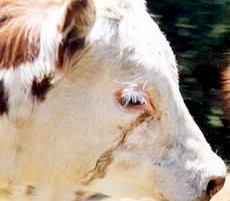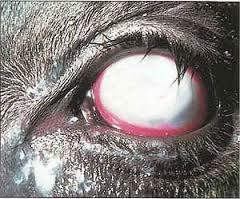Pinkeye in cattle this summer
02 Feb 2022
By Rohan Leach, Mixed Farming Advisor
Typically, pinkeye is seen in confinement feeding scenarios during summer. However, with abundant tall grass and thistles in pastures causing eye damage and irritation, this year pinkeye is shaping up to be a potential problem for producers.
Pinkeye is a bacterial infection of the eye that causes inflammation and, in severe cases, temporary or permanent blindness in cattle, sheep and goats. The infection can spread very rapidly through a herd and the economic impact due to weight loss and lowered milk production can be considerable. Pinkeye in sheep is very common in winter and is referred to as winter blindness, however due to timing and the current risks this summer, this article will focus on cattle.
Pinkeye in cattle is caused primarily by the bacteria, Moraxella bovis although the bacteria Mycoplasma and Neisseria are also known to cause infection. M. bovis produces a toxin which attacks the surface of the eye which erodes the surface, causing severe inflammation.
Predisposing Factors
Environmental factors that predispose livestock to pinkeye infection include:
- Dusty conditions
- High fly numbers
- Bright sunlight (summer)
- Physical irritation to the eye (such as from thistles or tall grass)
- Animals in close contact (yarded or high stocking densities)
Physical attributes of livestock such as un-pigmented eyelids and protruding eyes, may cause animals to become more prone to pinkeye. The white faces of Herefords make them more susceptible than other cattle breeds while British and European cattle are more susceptible than Bos indicus cattle.
Signs and Symptoms
 Pinkeye persists in a herd in the eyes of carrier cattle that do not show any signs of disease. Eye irritation from dust, bright sunlight, thistles and long grass can then cause damage which attracts flies. The flies feed on infected secretions and move from animal to animal, spreading the bacteria.
Pinkeye persists in a herd in the eyes of carrier cattle that do not show any signs of disease. Eye irritation from dust, bright sunlight, thistles and long grass can then cause damage which attracts flies. The flies feed on infected secretions and move from animal to animal, spreading the bacteria.
The first sign of pinkeye is profuse tear secretions and weepy, red eyes (Figure 1).
Closer investigation will show frequent blinking or the animal holding the eye partly closed. A white spot also begins to develop in the centre of the eye and is the beginnings of the formation of an ulcer. In many cases, the infection will start to heal without treatment intervention, with little sign of permanent damage.
Figure 1: First sign of pinkeye - tears running down the face of an affected animal (Source - crookwellvet.com.au)
 In more severe infections (Figure 2), the eye ulcer continues to enlarge over one to two weeks.
In more severe infections (Figure 2), the eye ulcer continues to enlarge over one to two weeks.
As the infection progresses, most of the eye becomes red as blood vessels grow across the cornea. Occasionally, the cornea may rupture, and the sightless eye will shrink back into the eye socket.
Figure 2: A more severe infection - (Source - crookwellvet.com.au)
During recovery the blood vessels start to recede, and the eye first becomes a cloudy blue colour, then begins to clear. Recovery is usually complete 3–5 weeks after the initial infection.
Treatment and Prevention
Pinkeye is a difficult disease to manage, as many producers will vouch for. If you see the early signs of weepy eyes in the paddock, careful monitoring of the mob is essential to ensure the disease does not progress. It may cause more harm than good yarding them to treat small numbers of animals in the early stages of the disease. Yarding animals brings them into dusty conditions and closer proximity with one another, increasing the likelihood of disease transmission. Alternatively, affected calves can be restrained and treated in the paddock.
However, in severe cases, advanced lesions are severely painful and cause loss of production which make treatment necessary based on animal welfare grounds. In situations where treatment is unavoidable or animals are being yarded for other management activities, there are a wide variety of treatment options. Ointments, powders, sprays and patches vary in effectiveness and simplicity of treatment. Powders and sprays have a very short activity and are irritant to the eye so should be avoided.
The use of single dose, topical ointments (e.g. cloxicillin which can only be purchased from veterinarians) is typically the easiest method to apply to large numbers of cattle. Intramuscular antibiotics along with anti-inflammatory injections can be more effective than topical ointments but are also more costly.
Covering of infected eyes with adhesive patches can reduce the irritation and pain that sunlight, dust and flies present to the healing eye infection. Additionally, the patches also slow the spread of infection to other animals in the herd. In valuable animals, getting the vet out to provide more intensive treatment is worth considering
It is possible to vaccinate against some strains of pinkeye causing bacteria in cattle. However, there are several different species and strains of bacteria that cause pinkeye which make immunising against the disease a challenging task. The current vaccine in the Australian market provides protection against 64% of Australian field M. bovis isolates (Coopers Piliguard Technical Manual, 2019). Producers must weight this up if it is economically and practically viable for them. It may be an option in high contact areas such as early weaning. Animals should be vaccinated 3-6 weeks before the onset of an outbreak meaning it may be too late to vaccinate if your herd is already showing symptoms.
With pinkeye, prevention is better than a cure and is also easier said than done. Some strategies include:
- Try and avoid working livestock in the elevated risk periods of summer and early autumn if you are seeing signs of pinkeye in your herds
- Reducing fly numbers through traps or use of dung beetles. Additionally, pour on insecticides and insecticidal air tags can also reduce fly numbers coming into contact with animals.
- Slashing, rolling or crimping tall grass and thistles to reduce irritation and potential for eye damage. Control of thistles in winter by use of herbicides is also advised.
- Good grazing management, including paddock selection and maintaining groundcover to minimise dust
If you would like further advice or information on pinkeye or other animal health considerations, please contact your local LLS District Vet or Ag Advisory team member.
Further Reading
Coopers® Piliguard® Pinkeye-1 Trivalent Vaccine Technical Manual (2019). Intervet Australia Pty Ltd.
B. Walker (2007) ‘Pinkeye in Cattle’. State of New South Wales through NSW Department of Primary Industries Primefacts. Primefact 336.